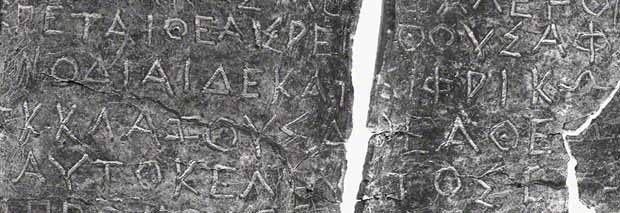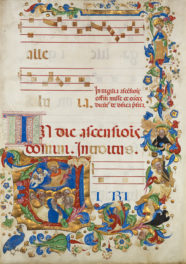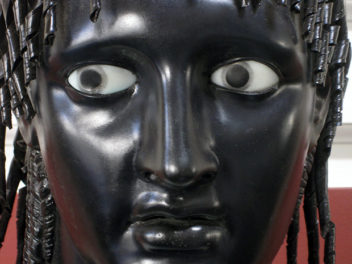
Jens Daehner, associate curator of antiquities (left) and Sarah Morris, professor of classics and archaeology at UCLA (right), take a close look at the Getty Hexameters.
Scholars from as far away as England and Holland and as near as Westwood recently gathered at the Getty Villa to decipher and discuss an enigmatic ancient Greek text inscribed on a now-fragmentary lead tablet. These so-called “Getty Hexameters” date to the fourth century B.C. and are of great interest to historians of ancient Greek poetry, religion, and magic.
The lead tablet bearing the verses is quite small, originally about the size of half a sheet of letter paper, and the lead on which the text is written is thin and thus has become very fragile. Lead was commonly used for inscriptions during this period both because it was available in abundance as a by-product in the refining of silver, and because it is soft, which means it can be easily written upon by scratching it with a stylus or pressing letter forms into it.

The Getty Hexameters, Greek, 300s B.C., made in Selinunte, Sicily. Six unjoined lamella fragments, text in Greek. The J. Paul Getty Museum, 81.AI.140.2. Gift of Dr. Max Gerchik
As a result, many lead tablets with ancient Greek texts survive, unlike those written on wax or papyrus, which have not stood the test of time. Most of the texts found on lead tablets are quite short. Pithy curses, for example, have been found in wells, where they were deliberately thrown in order to bring them closer to the gods of the Underworld, to whom they were usually addressed.
The text of the Getty tablet is not a curse, however; in fact, it is composed in dactylic hexameter, a meter best known from Greek hymns and epic poetry, including Homer’s Iliad and Odyssey.
While the text has yet to be fully deciphered, some of it is known in other versions, and comparisons to these variants offer important information about the practice of inscribing amulets and about how this practiced likely evolved from oral incantations.
Historians of religion are particularly intrigued by passages that present some kind of sacred tale involving the goddesses Demeter, Persephone, and Hekate, as well as the god Paian, a healing deity often associated with Apollo or Asklepios. Therefore, it appears that this tablet served a protective function, but further research is needed in order to understand it more fully.

Co-sponsored by the Center for the Study of Ancient Religions at the University of Chicago, and co-organized by Professor Christopher Faraone, a former Getty Villa Scholar, the gathering at the Villa began with a close reading of the text, drawing on sketches, photographs, and, most importantly, the tablet itself, which were temporarily removed from storage for up-close analysis. Invited speakers addressed various aspects of the texts, and vigorous discussion followed.
Research will continue on this enigmatic object, which we hope will reveal more of its secrets with further study.




I’m really glad that someone published this about writing on lead sheets which were a byproduct of silver production. I had not read about this process before, so that was exciting. When can we look forward to a translation being published? I’m very interested in what the text will say.
One of the goals of the workshop was to encourage publication of a translation, and in its wake I am pleased to report that two scholars, David Jordan and Roy Kotansky, have recently submitted a preliminary edition of the Greek text along with a translation to the Zeitschrift für Papyrologie und Epigraphik (ZPE), a German scholarly journal specializing in ancient texts. We hope that it will be published before the end of the year.